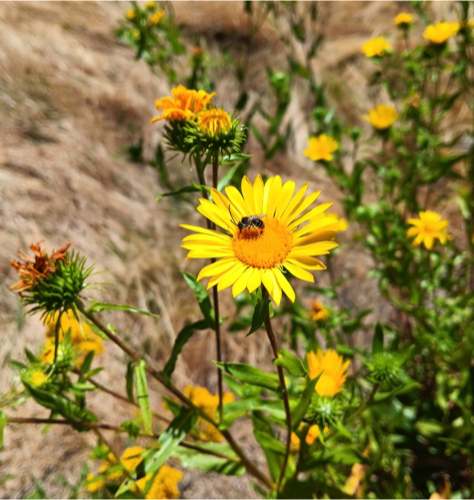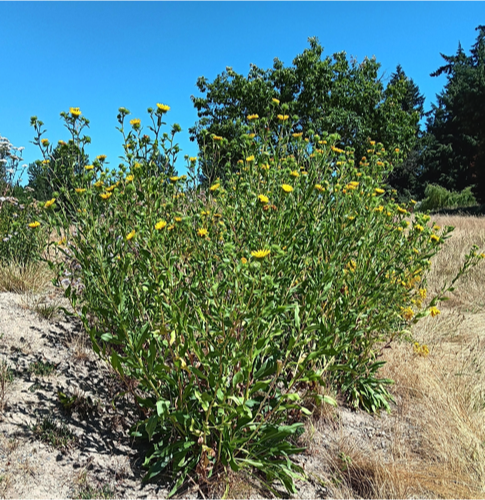 |
 |
by Marilee Henry
 |
 |
As fall approaches, when many flowers have finished their blooming periods, it is particularly important to provide some late season sources of pollen and nectar in our gardens for native pollinators. Puget Sound gumweed is a champion pollen and nectar source, not only in late summer, but throughout its long flowering season of June through September (and beyond!). Northwest Meadowscapes, a local supplier of native pollinator seeds, has called Puget Sound gumweed "The best late season bee plant in the Pacific Northwest."
This taprooted "subshrub" (woody only at its base) grows to about 4 feet in height and 2 to 3 feet in width, showcasing sunny yellow aster-like blooms atop bright green resinous curly-tipped bracts. The flowers attract native bees, butterflies, syrphid flies, wasps, beetles, and other beneficial insects. The genus Grindelia hosts 7 species of moth/butterfly larvae that are a critical high-energy food source for baby birds. Mature seeds are a desirable treat for several songbirds - a small pile placed near my birdfeeder disappeared within minutes!
Though this plant's native habitat is mostly along shorelines, coastal bluffs, fresh and saltwater marshes, and wet meadows in western Washington, it is also found in other non-marine habitats across the state and ranges from western Alaska and B.C. to Oregon and northern California. Given its wide range of occurrence, this species has no special soil or moisture requirements, making it a superb plant for raingardens, meadowscapes, and shorelines, to drier prairie-like environments such as that pictured above at Juanita Bay Park where it has bloomed since June with no supplemental watering - a very drought-tolerant plant for our changing climate! (For more images of gumweed: Burke Image Collection.)
Puget Sound gumweed will flower best in full sun but will tolerate partial shade. It seems just as happy in my heavy clay soil as it does in sandy loam or rocky/gravelly nutrient-poor soils. Though classified as a perennial, it may sometimes act like a biennial, flowering in its second year then dying out. But if spent flowerheads are left in place (remember, this is a great winter food source for birds!) they will readily reseed themselves. Seeds can easily be collected from the brown open seedheads for direct sowing in the ground or in containers in the fall. Seeds need cold stratification for about 3 months, so plant them no later than December and keep the containers outside (protect from digging squirrels with hardware cloth covering) to let nature chill them for you!
Remember, "You are nature's best hope!" - Doug Tallamy, author of "Nature's Best Hope" and "Bringing Nature Home".
Marilee Henry
Kirkland Community Wildlife Habitat Team Member, Washington Native Plant Society (WNPS) Native Plant Steward, Green Kirkland Steward, Finn Hill Neighborhood Alliance Contributor